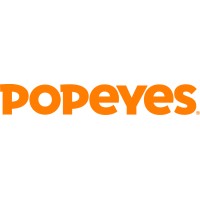Company Details
popeyes-louisiana-kitchen
24,533
89,164
7225
popeyes.com
0
POP_1311365
In-progress

Popeyes Louisiana Kitchen Company CyberSecurity Posture
popeyes.comFounded in New Orleans in 1972, POPEYES® has more than 45 years of history and culinary tradition. Popeyes distinguishes itself with a unique New Orleans-style menu featuring spicy chicken, chicken tenders, fried shrimp, and other regional items. The chain's passion for its Louisiana heritage and flavorful authentic food has allowed Popeyes to become one of the world's largest chicken quick-service restaurants with over 3,600 restaurants in the U.S. and around the world.
Company Details
popeyes-louisiana-kitchen
24,533
89,164
7225
popeyes.com
0
POP_1311365
In-progress
Between 750 and 799

 PLK Global Score (TPRM)
PLK Global Score (TPRM)XXXX

Description: Burger King, the world's largest fast food chain, exposed sensitive credentials to the public twice, endangering their systems and data. Burger King in France exposed private information to the public as a result of a website configuration error, the Cybernews investigation team found. People who applied for jobs at Burger King in France may have been impacted because the impacted website processed job applications. It's not the first time Burger King has exposed sensitive information; supposedly, the France branch exposed personally identifying information (PII) of children who purchased Burger King menus due to a similar misconfiguration.
Description: A French online shop Kool King specifically tailored to be used by kids who bought Burger King menus exposed nearly 37,900 records after a cyber attack. The data was leaked because the database storing it was misconfigured, allowing anyone with an Internet connection and the knowledge to find it to get to the records stored within. Since the database was not secured in any way and publicly accessible, anyone who reached it could then edit, download, or even destroy the data without needing admin credentials. The information compromised contained personally identifiable information (PII) such as emails, passwords, names, phones, DOB, voucher codes, links to the externally stored certificates, etc.100
Description: Ethical hackers **BobDaHacker** and **BobTheShoplifter** exposed severe security vulnerabilities within **Restaurant Brands International (RBI)**, the parent company of Burger King, Tim Hortons, and Popeyes. The flaws included **hard-coded passwords** (e.g., 'admin') in HTML and drive-through systems, **plain-text passwords sent via email**, and an **unrestricted API** allowing unauthorized admin access. The hackers gained entry to **employee accounts, internal configurations, raw audio recordings of drive-through conversations** (containing customer personal data processed by AI), and even **restaurant bathroom rating systems**. The breaches revealed **catastrophic oversight** in cybersecurity fundamentals, with no basic safeguards like antivirus checks or system audits. While the ethical hackers responsibly disclosed the issues and confirmed **no customer data was retained**, the exposure demonstrated how easily malicious actors could have exploited these gaps. RBI reportedly fixed the vulnerabilities post-disclosure but did not publicly acknowledge the researchers, raising concerns about long-term security improvements. The incident underscores systemic negligence in protecting **30,000+ global outlets** from potential data leaks, financial fraud, or operational disruptions.


No incidents recorded for Popeyes Louisiana Kitchen in 2025.
No incidents recorded for Popeyes Louisiana Kitchen in 2025.
No incidents recorded for Popeyes Louisiana Kitchen in 2025.
PLK cyber incidents detection timeline including parent company and subsidiaries

Founded in New Orleans in 1972, POPEYES® has more than 45 years of history and culinary tradition. Popeyes distinguishes itself with a unique New Orleans-style menu featuring spicy chicken, chicken tenders, fried shrimp, and other regional items. The chain's passion for its Louisiana heritage and flavorful authentic food has allowed Popeyes to become one of the world's largest chicken quick-service restaurants with over 3,600 restaurants in the U.S. and around the world.


On Aug. 8, 1950, an adventurous and determined entrepreneur named Harmon Dobson opened up the world’s first Whataburger on Ayers Street in Corpus Christi, Texas. He had a simple goal: to serve a burger so big it took two hands to hold and so good that after one bite customers would say, “What a burg

Founded by Todd Graves in 1996 in Baton Rouge, La., RAISING CANE'S CHICKEN FINGERS has over 800 restaurants in 41 states, with many new restaurants under construction. The company has ONE LOVE®—craveable chicken finger meals—and is continually recognized for its unique business model and customer sa
With 58,000 employees and more than 700 restaurants in the United States and Canada, and a growing international presence, Red Lobster is the world’s largest seafood restaurant company. Our vision is to be where the world goes for seafood now and for generations. Red Lobster is an innovative, v

Domino’s is a purpose-inspired, performance-driven company powered by exceptional people who are committed to feeding the power of possible—one pizza at a time. Founded in 1960 with a single store in Ypsilanti, Michigan, Domino’s has grown into one of the most recognized and leading pizza brands in

With strong, Midwestern family values and genuine hometown hospitality, Culver’s® has proudly served its signature ButterBurgers® and Fresh Frozen Custard since we opened our first restaurant in 1984. There are now over 1,000 Culver’s restaurants in 26 states, with more than 50,000 team members offe

We’re KFC. The iconic, brand making world-famous finger lickin’ good fried chicken since 1952. Our unrivaled people and culture are the true heart and soul of our brand. It’s where our people promise comes to life every day. Where our employees can be their best selves, make a difference, and have f
Pizza Hut, a subsidiary of Yum! Brands, Inc. (NYSE: YUM), was founded in 1958 in Wichita, Kansas, and since then has earned a reputation as a trailblazer in innovation with the creation of icons like Original® Pan and Original® Stuffed Crust pizzas. In 1994, Pizza Hut pizza was the very first online

Chili's opened as a fun Dallas burger joint with a loyalty to happy hour and blue jeans. We prided ourselves on our humble beginnings, following a devotion to great food, warm hospitality and community spirit. Today, with restaurants all over the world, we continue to cook up the best in casual fare
Wendy's was founded in 1969 by Dave Thomas in Columbus, Ohio. Dave built his business on the premise, “Quality Is Our Recipe®”, which remains the guidepost of the Wendy's system. Wendy's is best known for its made-to-order square hamburgers, using fresh, never frozen beef*, freshly-prepared salads,
.png)
Researchers found a host of vulnerabilities in the platforms run by RBI to service Burger King, Tim Horton's, and Popeyes.
McDonald's says a global systems outage affected several stores early on March 15. The company has worked to bring its locations back...
Learn why cybersecurity plays a vital role in protecting poultry processing plants and production facilities against malicious data...
Brunch with Peter Thiel turned into an impromptu pitch meeting for this former CIA analyst and current cybersecurity CEO Tim Junio.

Explore insights on cybersecurity incidents, risk posture, and Rankiteo's assessments.
The official website of Popeyes Louisiana Kitchen is http://www.popeyes.com.
According to Rankiteo, Popeyes Louisiana Kitchen’s AI-generated cybersecurity score is 787, reflecting their Fair security posture.
According to Rankiteo, Popeyes Louisiana Kitchen currently holds 0 security badges, indicating that no recognized compliance certifications are currently verified for the organization.
According to Rankiteo, Popeyes Louisiana Kitchen is not certified under SOC 2 Type 1.
According to Rankiteo, Popeyes Louisiana Kitchen does not hold a SOC 2 Type 2 certification.
According to Rankiteo, Popeyes Louisiana Kitchen is not listed as GDPR compliant.
According to Rankiteo, Popeyes Louisiana Kitchen does not currently maintain PCI DSS compliance.
According to Rankiteo, Popeyes Louisiana Kitchen is not compliant with HIPAA regulations.
According to Rankiteo,Popeyes Louisiana Kitchen is not certified under ISO 27001, indicating the absence of a formally recognized information security management framework.
Popeyes Louisiana Kitchen operates primarily in the Restaurants industry.
Popeyes Louisiana Kitchen employs approximately 24,533 people worldwide.
Popeyes Louisiana Kitchen presently has no subsidiaries across any sectors.
Popeyes Louisiana Kitchen’s official LinkedIn profile has approximately 89,164 followers.
Popeyes Louisiana Kitchen is classified under the NAICS code 7225, which corresponds to Restaurants and Other Eating Places.
No, Popeyes Louisiana Kitchen does not have a profile on Crunchbase.
Yes, Popeyes Louisiana Kitchen maintains an official LinkedIn profile, which is actively utilized for branding and talent engagement, which can be accessed here: https://www.linkedin.com/company/popeyes-louisiana-kitchen.
As of November 27, 2025, Rankiteo reports that Popeyes Louisiana Kitchen has experienced 3 cybersecurity incidents.
Popeyes Louisiana Kitchen has an estimated 4,808 peer or competitor companies worldwide.
Incident Types: The types of cybersecurity incidents that have occurred include Breach and Data Leak.
Detection and Response: The company detects and responds to cybersecurity incidents through an incident response plan activated with yes (after ethical hacker disclosure), and containment measures with patch applied to vulnerabilities (reportedly), and communication strategy with no public acknowledgment of ethical hackers or incident details..
Title: Kool King Data Breach
Description: A French online shop Kool King specifically tailored to be used by kids who bought Burger King menus exposed nearly 37,900 records after a cyber attack. The data was leaked because the database storing it was misconfigured, allowing anyone with an Internet connection and the knowledge to find it to get to the records stored within. Since the database was not secured in any way and publicly accessible, anyone who reached it could then edit, download, or even destroy the data without needing admin credentials. The information compromised contained personally identifiable information (PII) such as emails, passwords, names, phones, DOB, voucher codes, links to the externally stored certificates, etc.
Type: Data Breach
Attack Vector: Misconfigured Database
Vulnerability Exploited: Publicly Accessible Database
Title: Burger King Data Exposure Incidents
Description: Burger King, the world's largest fast food chain, exposed sensitive credentials to the public twice, endangering their systems and data.
Type: Data Exposure
Attack Vector: Website Configuration Error
Vulnerability Exploited: Website Misconfiguration
Common Attack Types: The most common types of attacks the company has faced is Data Leak.
Identification of Attack Vectors: The company identifies the attack vectors used in incidents through Hard-coded password in HTMLDefault 'admin' password in drive-through tabletsUnrestricted API signup.

Data Compromised: Emails, Passwords, Names, Phones, Dob, Voucher codes, Links to the externally stored certificates
Systems Affected: Database

Data Compromised: Personally identifiable information (pii), Children's pii
Systems Affected: Job Application WebsiteOnline Ordering System
Commonly Compromised Data Types: The types of data most commonly compromised in incidents are Emails, Passwords, Names, Phones, Dob, Voucher Codes, Links To The Externally Stored Certificates, , Pii, Children'S Pii, , Employee Credentials, Internal Configurations, Audio Recordings (Potential Pii), Operational Data and .

Entity Name: Kool King
Entity Type: Online Shop
Industry: Retail
Location: France
Customers Affected: 37900

Entity Name: Burger King
Entity Type: Corporation
Industry: Fast Food
Location: France
Incident Response Plan: The company's incident response plan is described as Yes (after ethical hacker disclosure).

Type of Data Compromised: Emails, Passwords, Names, Phones, Dob, Voucher codes, Links to the externally stored certificates
Number of Records Exposed: 37900
Sensitivity of Data: High
Personally Identifiable Information: emailspasswordsnamesphonesDOB

Type of Data Compromised: Pii, Children's pii
Personally Identifiable Information: Job ApplicantsChildren's PII
Handling of PII Incidents: The company handles incidents involving personally identifiable information (PII) through by patch applied to vulnerabilities (reportedly) and .
Key Lessons Learned: The key lessons learned from past incidents are Systemic neglect of basic cybersecurity practices (e.g., hard-coded passwords, plain-text credentials, unrestricted APIs) can expose global enterprises to severe risks. Ethical hacking revealed critical gaps in access controls, credential management, and operational security across RBI’s brands.

Source: Cybernews Investigation Team
Additional Resources: Stakeholders can find additional resources on cybersecurity best practices at and Source: Cybernews Investigation Team, and Source: Tom’s Hardware, and Source: Ethical Hackers’ Blog (Archived).
Communication of Investigation Status: The company communicates the status of incident investigations to stakeholders through No public acknowledgment of ethical hackers or incident details.

Root Causes: Misconfigured Database
Corrective Actions Taken: The company has taken the following corrective actions based on post-incident analysis: Patches Applied To Reported Vulnerabilities (Per Rbi), No Public Confirmation Of Broader Security Overhaul Or Policy Changes, .
Last Attacking Group: The attacking group in the last incident was an BobDaHacker (Ethical Hacker)BobTheShoplifter (Ethical Hacker).
Most Significant Data Compromised: The most significant data compromised in an incident were emails, passwords, names, phones, DOB, voucher codes, links to the externally stored certificates, , Personally Identifiable Information (PII), Children's PII, , Employee account credentials, Internal system configurations, Drive-through audio recordings (potential PII), Restaurant operational data (e.g., bathroom rating screens) and .
Most Significant System Affected: The most significant system affected in an incident was Job Application WebsiteOnline Ordering System and Equipment ordering websiteDrive-through tablet systemsAI-powered customer/staff evaluation systemsRestaurant management APIsBathroom rating screens.
Containment Measures in Most Recent Incident: The containment measures taken in the most recent incident was Patch applied to vulnerabilities (reportedly).
Most Sensitive Data Compromised: The most sensitive data compromised in a breach were passwords, Employee account credentials, Drive-through audio recordings (potential PII), emails, Personally Identifiable Information (PII), phones, links to the externally stored certificates, Children's PII, names, voucher codes, Internal system configurations, DOB, Restaurant operational data (e.g. and bathroom rating screens).
Number of Records Exposed in Most Significant Breach: The number of records exposed in the most significant breach was 379.0.
Most Significant Lesson Learned: The most significant lesson learned from past incidents was Systemic neglect of basic cybersecurity practices (e.g., hard-coded passwords, plain-text credentials, unrestricted APIs) can expose global enterprises to severe risks. Ethical hacking revealed critical gaps in access controls, credential management, and operational security across RBI’s brands.
Most Significant Recommendation Implemented: The most significant recommendation implemented to improve cybersecurity was Conduct regular security audits and penetration testing, Implement robust password policies and multi-factor authentication (MFA), Monitor dark web for exposed credentials or system access, Eliminate hard-coded credentials and enforce encryption for sensitive data, Restrict API access with proper authentication/authorization, Establish a transparent vulnerability disclosure program and Train employees on secure credential handling and phishing risks.
Most Recent Source: The most recent source of information about an incident are Cybernews Investigation Team, Ethical Hackers’ Blog (Archived) and Tom’s Hardware.
Current Status of Most Recent Investigation: The current status of the most recent investigation is Completed (by ethical hackers; RBI applied fixes but no public report).
Most Significant Root Cause: The most significant root cause identified in post-incident analysis was Misconfigured Database, Lack of basic cybersecurity hygiene (e.g., hard-coded passwords, plain-text credentials)Absence of access controls (e.g., unrestricted API access)Inadequate system audits and vulnerability assessmentsPoor credential management practicesCorporate neglect of security fundamentals despite global scale.
Most Significant Corrective Action: The most significant corrective action taken based on post-incident analysis was Patches applied to reported vulnerabilities (per RBI)No public confirmation of broader security overhaul or policy changes.
.png)
Angular is a development platform for building mobile and desktop web applications using TypeScript/JavaScript and other languages. Prior to versions 19.2.16, 20.3.14, and 21.0.1, there is a XSRF token leakage via protocol-relative URLs in angular HTTP clients. The vulnerability is a Credential Leak by App Logic that leads to the unauthorized disclosure of the Cross-Site Request Forgery (XSRF) token to an attacker-controlled domain. Angular's HttpClient has a built-in XSRF protection mechanism that works by checking if a request URL starts with a protocol (http:// or https://) to determine if it is cross-origin. If the URL starts with protocol-relative URL (//), it is incorrectly treated as a same-origin request, and the XSRF token is automatically added to the X-XSRF-TOKEN header. This issue has been patched in versions 19.2.16, 20.3.14, and 21.0.1. A workaround for this issue involves avoiding using protocol-relative URLs (URLs starting with //) in HttpClient requests. All backend communication URLs should be hardcoded as relative paths (starting with a single /) or fully qualified, trusted absolute URLs.
Forge (also called `node-forge`) is a native implementation of Transport Layer Security in JavaScript. An Uncontrolled Recursion vulnerability in node-forge versions 1.3.1 and below enables remote, unauthenticated attackers to craft deep ASN.1 structures that trigger unbounded recursive parsing. This leads to a Denial-of-Service (DoS) via stack exhaustion when parsing untrusted DER inputs. This issue has been patched in version 1.3.2.
Forge (also called `node-forge`) is a native implementation of Transport Layer Security in JavaScript. An Integer Overflow vulnerability in node-forge versions 1.3.1 and below enables remote, unauthenticated attackers to craft ASN.1 structures containing OIDs with oversized arcs. These arcs may be decoded as smaller, trusted OIDs due to 32-bit bitwise truncation, enabling the bypass of downstream OID-based security decisions. This issue has been patched in version 1.3.2.
Suricata is a network IDS, IPS and NSM engine developed by the OISF (Open Information Security Foundation) and the Suricata community. Prior to versions 7.0.13 and 8.0.2, working with large buffers in Lua scripts can lead to a stack overflow. Users of Lua rules and output scripts may be affected when working with large buffers. This includes a rule passing a large buffer to a Lua script. This issue has been patched in versions 7.0.13 and 8.0.2. A workaround for this issue involves disabling Lua rules and output scripts, or making sure limits, such as stream.depth.reassembly and HTTP response body limits (response-body-limit), are set to less than half the stack size.
Suricata is a network IDS, IPS and NSM engine developed by the OISF (Open Information Security Foundation) and the Suricata community. In versions from 8.0.0 to before 8.0.2, a NULL dereference can occur when the entropy keyword is used in conjunction with base64_data. This issue has been patched in version 8.0.2. A workaround involves disabling rules that use entropy in conjunction with base64_data.

Get company history
















Every week, Rankiteo analyzes billions of signals to give organizations a sharper, faster view of emerging risks. With deeper, more actionable intelligence at their fingertips, security teams can outpace threat actors, respond instantly to Zero-Day attacks, and dramatically shrink their risk exposure window.
Identify exposed access points, detect misconfigured SSL certificates, and uncover vulnerabilities across the network infrastructure.
Gain visibility into the software components used within an organization to detect vulnerabilities, manage risk, and ensure supply chain security.
Monitor and manage all IT assets and their configurations to ensure accurate, real-time visibility across the company's technology environment.
Leverage real-time insights on active threats, malware campaigns, and emerging vulnerabilities to proactively defend against evolving cyberattacks.




